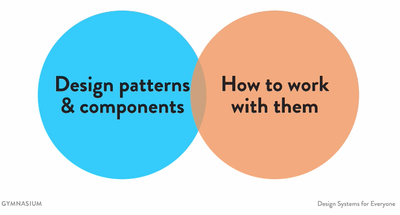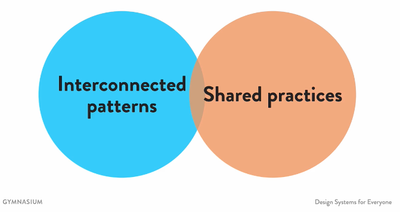Design systems for everyone
Ethan Marcotte has four new courses on design systems, available for free at Aquent Gymnasium. These are my notes about the excellent first course, Design systems for everyone.
Introduction
- Design systems bring structure and purpose to design patterns.
- Design systems help to make patterns more visible and more organized.
- Design systems can help make our products more manageable and consistent.
- Design systems can help to communicate more clearly.
What is a design system
Examples:
- Olympic Games 1972 Munich, by Otl Aicher
- Mailchimp
- IBM Carbon Design System
- Starbucks Pattern Library complemented by Our new expression
- Salesforce Lightning Design System
- Further information at Alla Kholmatova
A design system consists of patterns & components as well as guidelines how to work with those patterns.

Why do we need design systems
- Design patterns are reusable pieces of interface design.
- A pattern library is a well-structured and accessible collection of patterns. Often managed by software such as Storybook, Pattern Lab, or Fractal. A good pattern library meets the needs of the people using it. It has to be accessible to them. Which means it has to be organized, categorized, and navigable. Also, teams have to be able to contribute to the pattern library.
A design system provides designers, developers, and product managers a shared language to improve on the following things:
- design standards
- consistency
- less redundancy
- an extensible system
- documentation
- coding standards
- improved shipping times
A design system is a way to improve the way your team works.
Conducting a pattern library
- A design pattern is a reusable piece of design.
- Have a conversation about the purpose of the patterns.
Naming and organizing design patterns
A good pattern name should describe the patterns by purpose or function, not by their appearance. Examples:
- Featured teaser card
- Teaser card
- Teaser
Language is the primary interface for design patterns.
See a workshop format by Charlotte Jackson that can be used with customers. Its documented in the alistapart article From Pages to Patterns: An Excercise for Everyone. It goes:
- Visual inventory of patterns
- Cut up each page of your website into its smallest elements (paper!)
- Group similar elements
- Remove duplicates
- Name patterns
- Pick an element
- Each person in the group writes a name for it (focus on function, not looks)
- Names are secret until they are revealed
- Compare and discuss in the group
- Repeat for each component
- Structure the patterns into categories, because that is the primary interface for finding the patterns. Example: Marvelapp Styleguide under components. Alternatively look at DFPB Design System.
This is how a shared language can emerge from the design patterns
Creating a pattern library
This is three-step process and the first two steps are done:
- Create a pattern inventory (done)
- Name and group patterns (done)
- Building the library
Approaches:
- Use static HTML – This is for smaller systems.
- Use storybook.js.org.
- Use fractal.build
Evolving a pattern library into a design system
A design sytem is a set of interconnected patterns and shared practices coherently organized to serve the purpose of a digital product.

Defining the shape of a design system
Answer the question for yourself: Why are you building a design system? The purpose of a design system is defined by its audience and its direction.
- To define the direction of the design system, as a group, ask early in the process:
- How will we know if our design system is successful?
- How will we know if this is working?
- Dedicate time to explore the needs of the design system´s audience.
- Who will create the design system?
- Which product/s will use the design system?
- Who will be the system´s contributors and its consumers?
- How and why will they be using the design system?
- You know things are working, if
- Consumers are shipping features based on the design system.
- You´re getting regular feedback from contributors and consumers.
- The maintainers of the system have established a regular pace of updates.
- Consumers and contributors have begun sharing best practices and resources.
A good design system is aligned with the needs of a product as well as the needs of the people working with it.
Visit A design system isn´t a project. It´s a product, serving products, by Nathan Curtis.
Common myths about design systems
- We need to start our design system from scratch.
- You already have a design system!
- Your product already has (uninventoried) patterns and your team has existing (albeit not ideal) practices.
- Start by inventoring what exists, in order to understand how to proceed.
- We have to roll out the entire design system at once.
- Design system work is slow and iterative.
- It´s okay to release it in a gradual cadence.
- Consider shipping revised components as they are ready, redisigning your product´s interface little by little. See The hardest thing about design systems, by Robin Rendle.
- That other organization makes design system work look so easy.
- The pattern library for the design system is just the artifact. You´re not seeing the work that goes into it.
- Every design system has failed.
- It´s important for teams to be able to identify problems and discuss openly to adjust and proceed.
- We´ll launch our design system, and then we´ll basically be done.
- A design system isn´t a project, it´s a product.
- Design systems work is never finished, they are evolving ecosystems. And that´s good! See Building a visual language.
Further Reading
Design Systems, by Alla Kholmatova
Comments